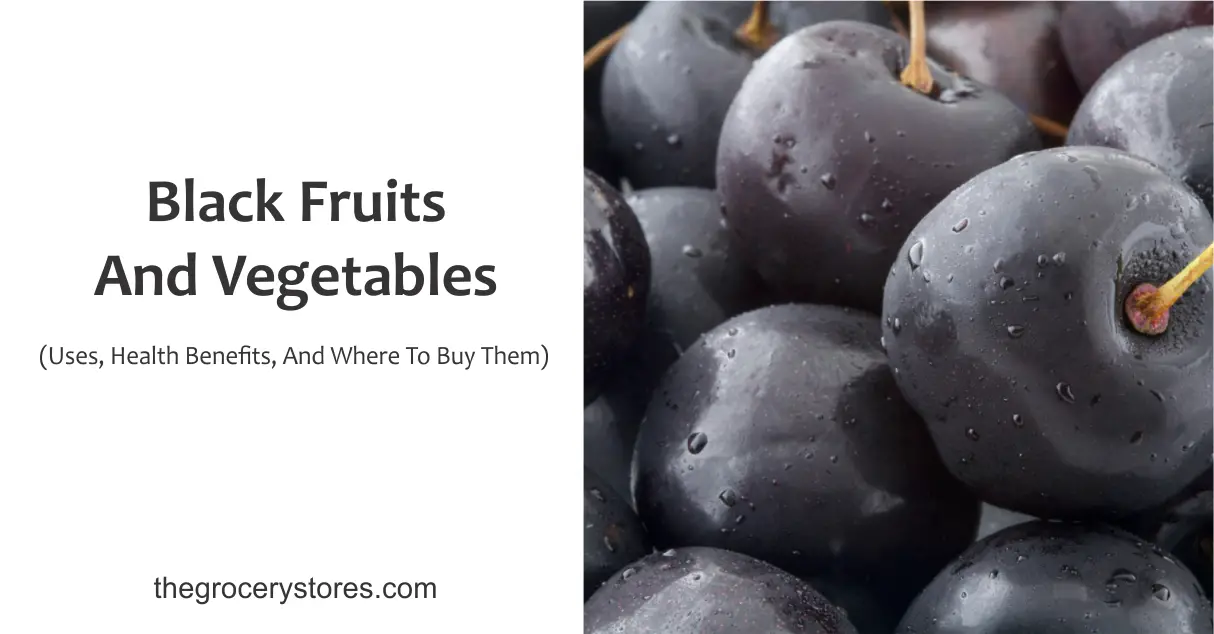There are basically two things to look at here: black fruits and vegetables. But we’ll start with Black Fruits.
Black fruit is a pretty broad concept that is used to describe fruits like black currants, plums, black cherries, and any black-skinned fruit you may have thought of.
While black vegetables describe vegetables like lentils, black radish, etc. Their colors vary from black, very dark purple, dark blue, or dark green. The dark-colored skin of fruit and vegetables comes from two flavonoids, namely anthocyanin and anthoxanthin.
Ten black fruits and vegetables you should know about.
1. Black plums (syzygium cumini)
When talking about these black fruits, plums make the list with a description of small, round or slightly oblong fruits, and they have a rather smooth skin. Plums have just one inner seed, and the flesh takes on a variation of color, ranging from dark red, purple, or yellow. Plums have an equilibrium of sweet and tart flavors. When used to make fruit juice, this liquid juice can easily stain fabric or even the skin.
What’s the origin of black plums?
Though not much is known about the fruit, it is believed to be native to India and some parts of southeastern Asia. However, these trees love the tropical climate and spread to other areas, where they attracted popularity for their very high nutritional and medicinal value.
Uses of Black plums
- Plums may be consumed raw or made into jams.
- Plums can be used for baking.
- The main fruit has been used as an addition to sorbet, salad, and sauce.
- The whole tree is very valuable as wood. It is resistant to water when dried enough and can be used to make durable furniture.
Health benefits of Black plum
- In traditional Chinese medicine, the specific healing targets for black plums are the liver and gallbladder.
- Plums stimulate gastrointestinal health by stimulating the digestive tract.
- Plum, as an herb, helps with urine and keeps the liver clean.
- Plum assists in relieving constipation.
- Plums control high blood pressure and reduce blood sugar.
Interesting facts about plums
- A kind of black plum tree bears white fruit.
- Some well-known names for black plums are Java plum, Jambolan, and Malabar plum. They are often referred to as Indian berries.
- Plum trees in a profitable year bear fruit of about 80-100 lbs.
- Some people believe eating one plum every day will help to achieve smooth skin.
Growing Black plums trees;
Black plum trees are evergreen and prefer tropical climates. Growing close to 100 feet in height, the bark starts off dark and rough and becomes lighter higher up the tree. The black plum tree is a resilient species, but can be susceptible to black knot, canker, leaf spot, and brown rot.
2. Black grapes (vitis vinifera)
Black grapes have a wealth of nutrients and delay aging. Humans have been growing black grapes for more than 8,000 years. Additionally, they include a wealth of healthy elements that enhance bone, skin, and heart health as well as general wellbeing. Grapes can be grown in a suitable environment or purchased from fruit stores around you.
The origin of grapes
Grape cultivation began as early as 6,500 B.C. Grape wine was so important to the ancient Greeks and Romans that they worshiped a god of wine and pleasure. Today, Italy, France, and the United States are the world’s top producers of grapes.
Uses of Black grapes
- It can be used to make wine.
- Most people consume grapes in their raw state because of their sweet flavor and nutritional value.
- Like other fruits, it can be used for baking purposes.
Health benefits
- Black grapes are a powerhouse of antioxidants, apart from their vitamin C value.
- Anthocyanins and resveratrol in black grapes may lower the risk of heart disease by preventing atherosclerosis and lowering blood cholesterol levels.
- Grapes help provide anti-diabetic effects due to the presence of resveratrol, which aids blood sugar control.
- Grapes provide anti-cancer properties because of an antioxidant that is believed to stop the growth of cancer.
- Grapes are good for your eyes.
- Grapes help boost memory.
3. Black apples (malus domestica)
Given how improbable it is that you would ever have the opportunity to try one, it almost feels unjust to include black apples in this list of black fruits. These magically beautiful apples, also known as Hua Niu apples, are grown in Tibet and Nepal and are exorbitantly priced.
If you ever have the chance to travel to either nation, make an effort to find some of these fruits! Their meat, which is a creamy white beneath the glossy black pigmentation, is supposed to be exceptionally sweet and juicy. They are rare and hard to find except where they are grown, but in the US they can be found in Arkansas.
Uses of Black apple
- They are often eaten in their raw state like other sweet fruits.
- They can be used in pastries and baked goods like other fruits,
- They are also used as recipes for fruit juice.
- When canned, they can be used as apple butter.
Health Benefits of Black apples.
This variety lacks the health benefits of a typical apple, which provides 4 grams of fiber and the flavonoid epicatechin, which lowers blood pressure. Additionally, each apple might cost you anywhere from $7 to $20.
4. Black Currant (ribes nigrum)
Its scientific name is Ribes nigrum, and it belongs to the family of Grossulariaceae in Kingdom Plantae. It is indigenous to temperate regions of central, northern, and eastern Europe, as well as northern Asia, and thrives in moist, fertile soils. It is widely grown both commercially and domestically. It can also be purchased from fruit stores or grocery shops near you.
Uses of blackcurrant.
- The seed oil, leaves, and flowers can be used to make medicines.
- It can be consumed in its raw state, like every other fruit.
- It can also be used to make fruit juice.
Health benefits of Black Currant.
- They help boost the immune system.
- They are high in antioxidants and vitamin C.
- Currants have a direct effect on the body’s inflammatory responses.
- Black currants are rich in vitamin C and contain GLA and linoleic acid, which are good for the eyes.
5. Black Raspberries (rubus occidentalis)
These berries are native to North America. They are commercially farmed in Oregon, though they grow virtually throughout the United States. While they bear raspberries, the black raspberry is much more favored in flavor than the other varieties.
It is native to temperate areas of central, northern, and eastern Europe as well as northern Asia, and it grows best in damp, fertile soils. It is commonly grown in both residential and commercial settings. It belongs to the family of Rosaceae in the plant kingdom. Scientific name: R. occidentalis.
Black raspberries have a life span of 5–10 years, depending on pests and adverse environmental conditions, whereas red raspberries have a longer life span.
Uses for Black Raspberries
- They can be used as food coloring because of their dark colors.
- They can be consumed whole as regular fruits as well.
- They can be used to make ice-cream and fruit juices.
Health Benefits of Black Raspberries
- They are high in antioxidants.
- They are an excellent source of fiber.
BLACK VEGETABLES
Some black vegetables include eggplant, black beans, black radishes, black pepper, black lentils, and black kale. We will be looking at a few of them, with their uses, health benefits, and how to grow them.
1. Black pepper (piper nigrum)
Black pepper is a flowering vine in the Piperaceae family that is grown for its peppercorn-shaped fruit, which is used as a spice and condiment and is typically dried. The fruit is a drupe that has a stone inside that contains a single pepper seed. It is dark red and about 5 mm in diameter.
Uses of black of Black pepper.
- It can be used as a spice for our meals.
- It can be used to prepare marinades.
Some health benefits include
- High in antioxidants
- It helps to increase control of blood sugar.
- It also aids body detoxification.
- Cancer prevention.
- Black pepper cleanses the intestine.
Black pepper can be planted in your garden or gotten from your grocery store near you.
2. Black kale (lacinato kale)
It is a vegetable used mainly for cooking. It has a slender look and great-textured dark green leaves on a long stalk. It is abundantly available from late fall through spring.
Uses of Black kale
- It is used for cooking as a vegetable.
- It can be used to make salads.
- It is sometimes used as a pizza topping.
- Kale can be steamed, fried, or eaten raw.
Health Benefits of Black kale.
It contains fiber, vitamin C and k, antioxidants, iron, etc., which can help prevent several health challenges.
3. Black lentils (vigna mungo)
Lentils, due to their resemblance to caviar, are sometimes referred to as beluga caviar. Like black garlic and rice, lentils are one of the necessary ingredients to have right now . They can be purchased from Walmart supermarkets, the Illinois Whole Food Market, and even from your regular grocery store and online.
Health benefits of Black lentils
They present an affordable means to pack your meal with a diet as they serve as a good source of vitamins B, iron, zinc, copper, potassium, and they are high in energy-providing protein.
Uses of lentils
They can be used in preparing our diets as they serve as a good source of dietary nutrition and are affordable too.
It is important to note that black lentils have a more intensely earthy flavor compared to other varieties of lentils.
4. Eggplant (solanum melongena)
The scientific name of this plant is Solanum melongena. Its flavor is similar to zucchini. Due to its soft nature, eggplant absorbs the flavor of whatever it is prepared with.
Health benefits
- They are abundant in fiber and antioxidants. It also contains vitamins. In addition, they serve as a good source of phenolic compounds.
- Polyphenols in eggplant help protect the body from cancer.
Uses of egg plants
- Eggplant is a good addition to our wonderful cuisine.
One of the biggest secrets to growing eggplant is giving it enough light. If you want to grow eggplant, two important factors to consider are your location and the right variety.
5. Black Radish (raphanus sativus var. radish)
This is a type of root vegetable grown predominantly during the winter. They belong to the Brassicaceae family. It can also be known as efurter radish or black Spanish radish. The edible root’s white flesh and stiff black skin are both edible. There are elongated and circulated types.
Health benefits of Black radish.
- This vegetable protects the skin from inflammatory conditions due to its detoxifying properties. This is made possible by the presence of vitamins B and E.
- The presence of vitamin C makes this vegetable help boost the immune system.
- This vegetable aids in regulating life function due to the presence of glutathione, an antioxidant.
- Other benefits include its anticancer potential and helping with weight loss due to low calories and high fiber content.
Uses of Black radish
- They can be added to salads in their fine slices.
- Black radishes can be baked into chips.
- They can be eaten by frying them in butter.
They can be ordered online from the Amazon store, or found at your local grocery store.

